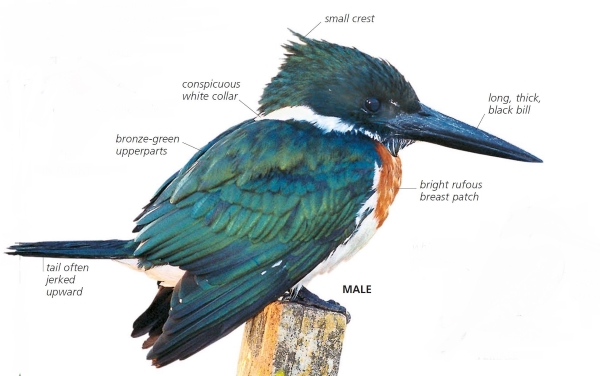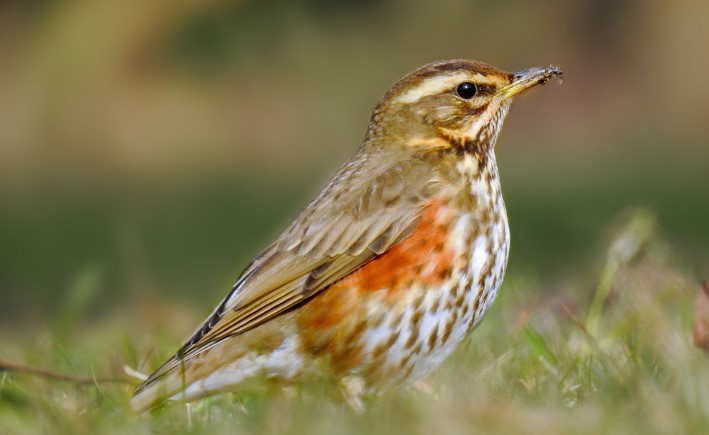Habitat: The green kingfisher lives around the forested edges of freshwater lakes, ponds, and streams. It enjoys still or slowly flowing water, and while it needs low vegetation to find perches for hunting, it usually prefers a habitat that is more open than densely forested. It inhabits its range year-round, however, it may cover a distance of up to one kilometer along a river. The female bird perches on a twig near the water’s surface, usually waiting to dive to feed on fish.
Identification: The green kingfisher is the smallest of the three species of North American kingfishers. Its noticeable white collar and relatively huge bill help to identify it. The female lacks the male’s rufous breast and instead has a necklace of white spots. Males have a striking rust-red chest, while females have two tidy green bands across the breast. A juvenile’s crown and wing coverts contain little buff dots, and they are duller than a female’s.

Distribution: It is not particularly abundant; it is found in south Texas and Arizona in its United States range. Its range outside the US extends across the Americas, from Mexico down to southern South America (Chile and Argentina).
Behavior: Compared to the raucous Belted Kingfisher, the Green Kingfisher is usually considerably less noticeable and glows like an emerald in brilliant sunlight. Green kingfishers have two partially fused, forward-facing toes, just like other kingfishers. (This configuration of the toes is called “syndactyl.”). Like other kingfishers, it dives from perches over water to catch aquatic prey. Birdwatchers lucky enough to see this glittering green jewel will gain a glimpse into tropical birdlife.
Vocalizations: The green kingfisher call is staccato “ticking”; also harsh, buzzy scold; quieter than the other two North American kingfishers. A certain vocalization “resembles the sound of two stones, generally single or double, striking together.”
Nesting: The green kingfisher nesting excavates burrow up to three feet (90cm) deep into dirt banks above water, along rivers and streams, with entrance concealed by overhanging vegetation.
Eggs: This species lays 4–5 eggs. Only one brood a year; March–July. The eggs are laid on the earth at the end of a nest burrow rather than in a conventional nest. The incubation phase lasts between 19 and 21 days; typically, the parents alternate during the day while the female incubates at night. Fish scales, bones, and insect wings are among the food scraps that accumulate around the nest chamber while the parents tend to feed their young. The young leave the nest in 26–27 days.

Feeding: The green kingfisher actively plunges from various types of perches. Sometimes they hover briefly over clear water before diving to catch small fish; occasionally they feed on small crustaceans and mollusks.
Other Names: This bird is also known as Little Green Kingfisher, Texan Kingfisher, Texas Kingfisher
Flight: Green kingfisher flight is direct but fast, just above the water’s surface, with deep and downstroke wing beats.
Length: The green kingfisher’s average length is about 22 cm (8 ½ inches).
Social: It’s a solitary bird.
Wingspan: The wingspan is about 28 cm (11 inches).
Lifespan: During a banding operation in Texas, the eldest Green Kingfisher, who was five years old at the time, was recaptured and released.
Weight: The average weight is about 35–40 grams (1¼ –17⁄16 oz)
Status: It’s a localized bird. It is classified as least concerning by the IUCN. Its range is very broad. Its population is more than 20 million mature pairs.
Where to Find: Breeds and winters near wooded shorelines of lakes, ponds, and streams. The green kingfisher prefers clear, slow-moving water with low, overhanging vegetation and plenty of suitable perches. It tends to avoid muddy water. Its range in the United States is restricted to small parts of Texas.
Family: Alcedinidae
Species: Chloroceryle americana
Order: Coraciiformes
Races: There are five subspecies that are recognized:
-
a. americana (JF, Gmelin in 1788)
-
a. cabanisii (Tschudi in 1846)
-
a. septentrionalis (Sharpe in 1892)
-
a. mathewsii (Laubmann in 1927)
- C. a. hachisukai (Laubmann in 1941)
Read More: Sacred Kingfisher (Todiramphus sanctus)







